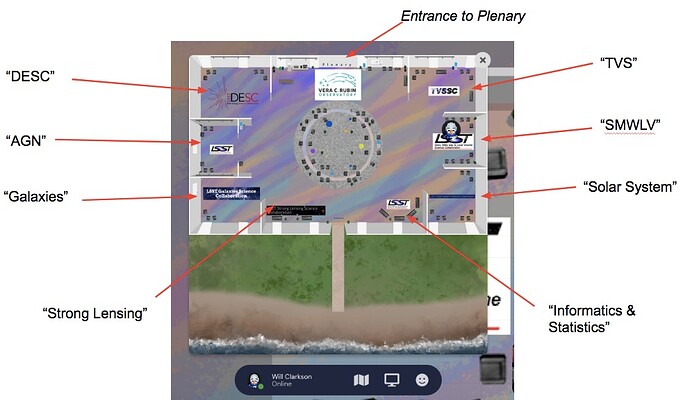Hi all - we will be having another SMWLV-TVS hack day on Tuesday April 13th, 1000-1500 EDT. Similar timing as previous hack days (a 1000-1200 EDT and a 1300-1500 EDT session), you should feel free to attend as much or as little of this as you like.
We’re hoping to focus this hack day on cadence notes writing, and thus we expect the structure will be a bit looser than previous hack days: groups will likely claim spaces within the Gathertown meeting space to work together on their cadence notes. The meeting space key is shown below.
Here are links to the signup sheet and the welcome slides for hack day 6. Signing up is not required for attendance, but it will help us get an idea of who wants to work on what.
By request, here follow the example questions the SCOC indicated to help investigators focus their input, pasted from the SCOC Cadence Input Solicitation (pdf), which can be found on the SCOC page. (Note that the solicitation document from the SCOC also includes some help on addressing these questions.)
-
" Are there any science drivers that would strongly argue for, or against, increasing the WFD footprint from 18,000 sq. deg. to 20,000 sq.deg.? Note that the resulting number of visits per pointing would drop by about 10%. If available, please mention specific simulated cadences, and specific metrics, that support your answer."
-
“Assuming that current system performance estimates will hold up, we plan to utilize the additional observing time (which may be as much as 10% of the survey observing time) for visits for the mini-surveys and the DDFs (with an implicit assumption that the main WFD survey meeting SRD requirements will always be the first priority). What is the best scientific use of this time? If available, please mention specific simulated cadences, and specific metrics, that support your answer.”
-
“Are there any science drivers that would strongly argue for, or against, the proposal to change the u band exposure from 2x15 sec to 1x50 sec? If available, please mention specific simulated cadences, and specific metrics, that support your answer.”
-
“Are there any science drivers that would strongly argue for, or against, further changes in observing time allocation per band (e.g., skewed much more towards the blue or the red side of the spectrum)? If available, please mention specific simulated cadences, and specific metrics, that support your answer.”
-
“Are there any science drivers that would strongly argue for, or against, obtained two visits in a pair in the same (or different) filter? Or the benefits or drawbacks of dedicating a portion of each night to obtaining a third (triplet) visit? If available, please mention specific simulated cadences, and specific metrics, that support your answer.”
-
“Are there any science drivers that would strongly argue for, or against, the rolling cadence scenario? Or for or against varying the season length? Or for or against the AltSched N/S nightly pattern of visits? If available, please mention specific simulated cadences, and specific metrics, that support your answer.”
-
“Are there any science drivers pushing for or against particular dithering patterns (either rotational dithers or translational dithers?) If available, please mention specific simulated cadences, and specific metrics, that support your answer.”
If you are unclear how to interpret these questions, we recommend getting in touch with an SCOC member (Slack message may be easiest for those of you who use Slack). The SCOC membership list (including the SMWLV and TVS reps) is at the bottom of the SCOC page.
Here is a key to the Gathertown meeting space with room labels indicated:
Links to previous SMWLV-TVS hack days:
